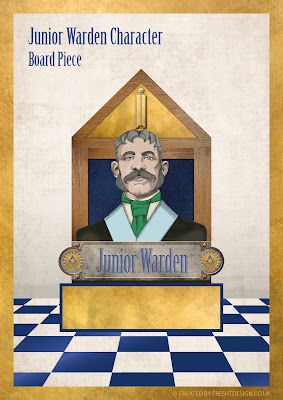I wish I could report the arrival of this game on the market so you could amuse yourselves in small groups during this period of social distancing, but On the Square is still being developed, and a pending Kickstarter campaign will get it into production soon.
On the Square is the first board game slated for production by a company founded by two Freemasons in the United Kingdom. Matthew & Michael Limited is their game design and production studio, founded last year. Perhaps in keeping with the Masonic number three, another Mason, a specialist printer in Lancashire, will bring this game to fruition. In addition, a percentage of the profits will go to the Masonic Charitable Foundation.
The specs of On The Square include:
- Suitable for 2-4 players, with 5-6 player expansion available
- Play is between 25 and 45 minutes for 4 players
- Suitable for ages 14 and up
How do you play? From the publicity:
 |
| Prototypes of the game board. |
On the Square is a new game based on the mysteries and secrets of Freemasonry. Lots of playability, multiple characters, and unique game mechanisms add an exciting strategic edge to traditional roll and move game. Superbly designed and illustrated, quality components, robust and well tested.
On the Square is a traditional, easy to understand and exciting game. You play as one of the six senior officers of the lodge to collect the tools of the three degrees while advancing through the game in the proper steps. Look out for gavel knocks and go on the square to reach the goal of Worshipful Master.
The gavel strikes! The Worshipful Master commands that you prepare yourself properly to enter the lodge in the correct degree and advance by the proper steps, taking your rightful position in your officer seat.
As the lodge door opens and you are admitted by the Tyler and Inner Guard, you must progress around the lodge, through each of the three degrees. Collect the tools of your degree to show your progress, and collect the secrets and mysteries of each officer of the lodge.
During your time in the lodge you are required to obey all the summonses from the secretary and heed the advice of the seniors. Visiting brethren will be on hand to help you progress.
At times, you will have the opportunity to go “on the square” and use your tactical skill, whilst moving in the proper form, to advance. From time to time you will have the opportunity to introduce a new candidate to the lodge, it is your duty to guide him thoughtfully throughout, and when you have completed your journey, you must immediately take your officer’s seat and you can become Master of your lodge.
I will report the progress of On the Square here on The Magpie Mason.



























































































